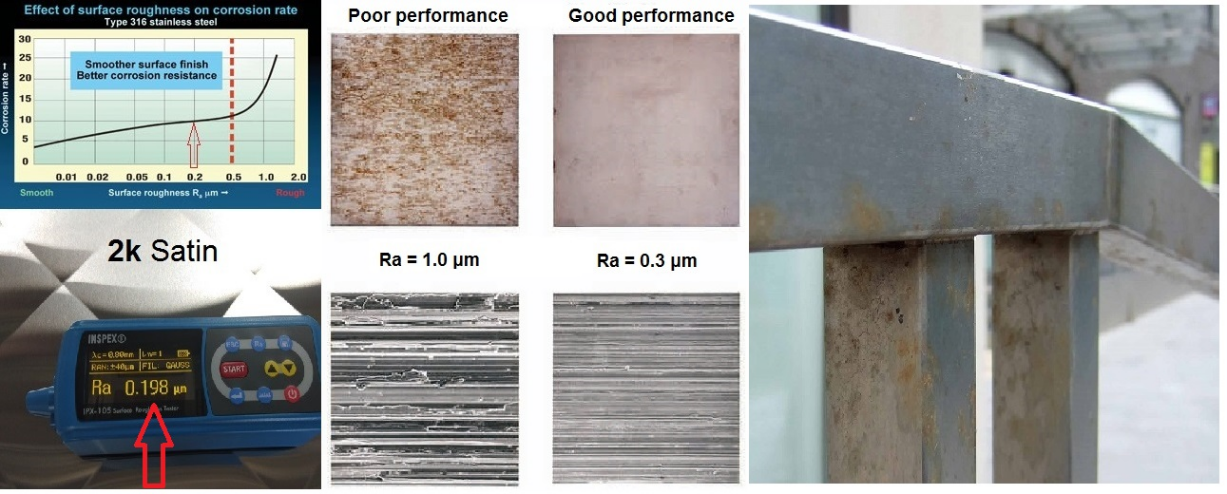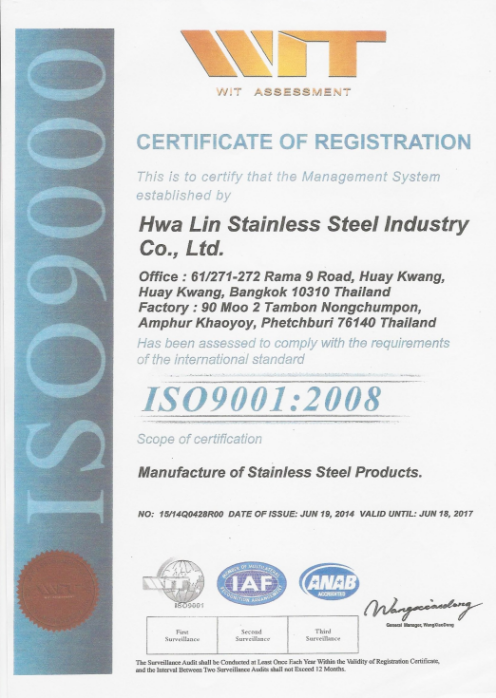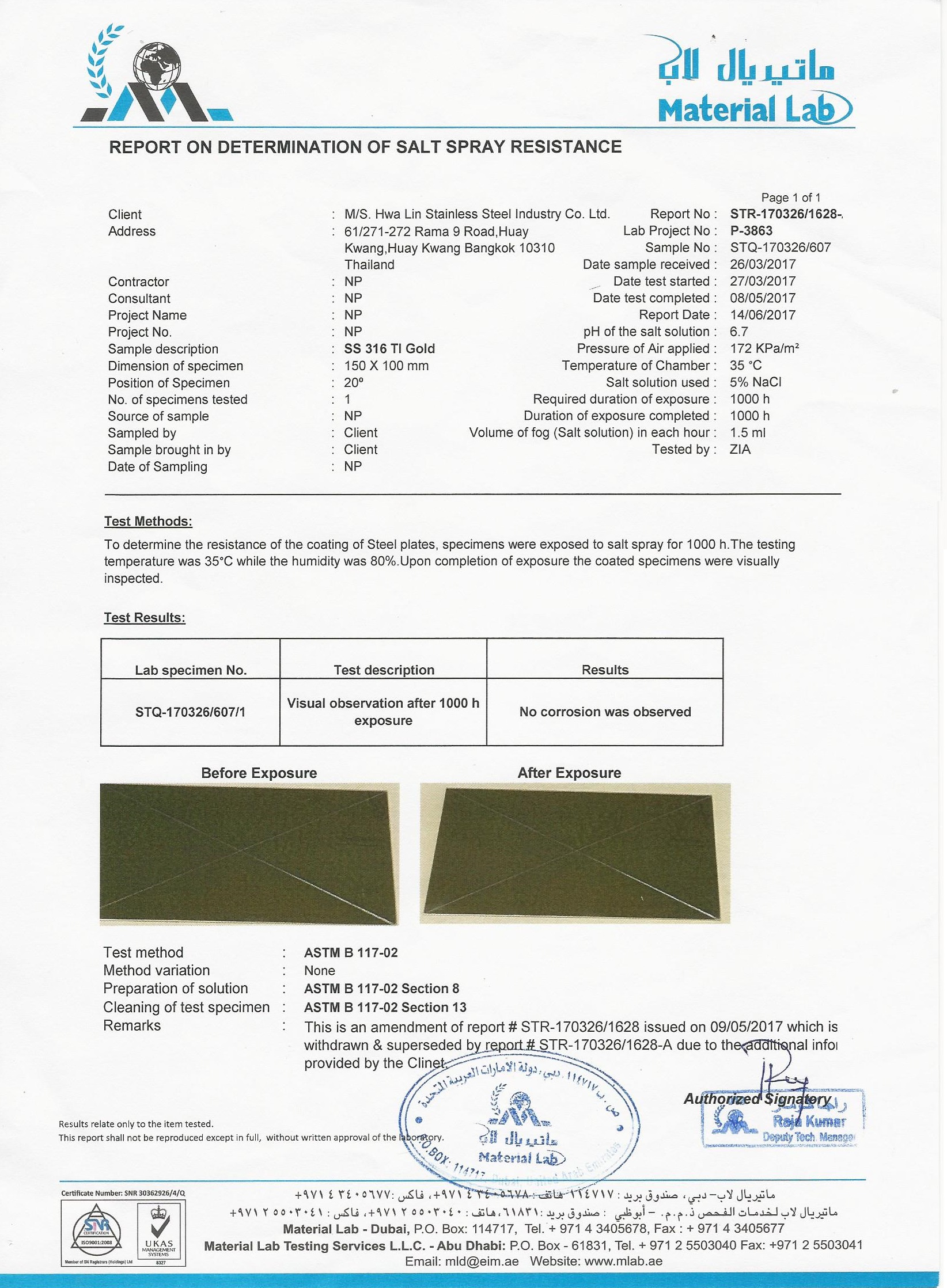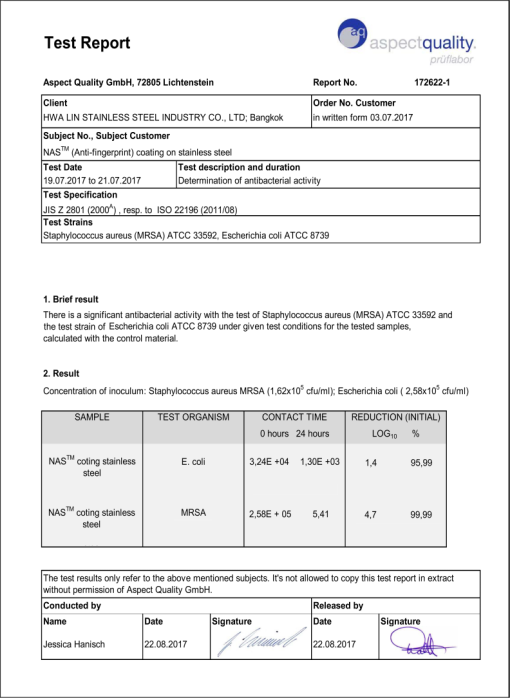
March 31, 2021
High Corrosion Resistant Satin
Introduction
It has long been recognized that the surface finish on stainless steel has an important effect on its corrosion resistance.
Despite this, the message clearly needs to be reinforced from time to time. The mere specification of 1.4401 (316) type stainless steel for exterior architectural applicationsis not in itself sufficient.
Why Surface Finish is Important
Directional ‘dull’ Satin finishes are often specified for external architectural applications, but this type of surface finish can exhibit a wide range of surface roughness dependent upon the type of machine "Dry" or "Wet" polishing and grit of the belt that has been used. Coarse polished finishes, with transverse Ra values > 1 micron, will exhibit deep grooves where chloride ions can accumulate and destroy the passive Chromium Oxide film, thereby initiating corrosion attack. In contrast, fine polished finishes with Ra values < 0.5 micron will exhibit clean surfaces, with few sites where chloride ions can accumulate. If a directional polished finish is required, in a coastal/marine situation, it is important that the specification should include a ‘maximum’ transverse surface roughness requirement of 0.5 microns Ra (e.g. a 2K surface finish in EN10088-2). A simple description, such as satin polish, would be insufficient to guarantee a smooth polished finish with good corrosion resistance.
Development of a Surface Finish Standard
Work carried out in the late 1970’s, at British Steel’s Swinden Laboratories, showed that dull polished finishes on stainless steel (falling within the generic No 4 finish designation of British Standard BS1449 part 2) could exhibit a wide range of surface roughness, with transverse Ra values ranging from 0.2 to 1.5 microns. Scanning Electron Microscopy (SEM) revealed that the samples with a high surface roughness (Ra > 1.0 micron) were heavily damaged by the polishing operation, whilst those with low surface roughness were relatively undamaged, showing only light scoring of the surface.
During the mid-1980’s, dull polished finishes were used in a variety of situations, including some prestigious architectural applications. However, it soon became apparent that some of these dull polished finishes had poor corrosion resistance especially when placed at coastal sites. To determine the cause of this variation, British Steel Stainless carried out an extensive program of polishing trials, in conjunction with various stockholders/polishers, using different polishing grits and belt types. Samples from each of these trials were submitted to a 21-day accelerated cyclic salt spray test at Swinden Laboratories. The results clearly showed that surface roughness had a controlling influence on the degree of surface staining with ‘coarse’ polished finishes (Ra > 1.0 micron) showing high levels of staining, whereas ‘smooth’ polished finishes (Ra 1.0 micron) exhibiting considerable surface damage from the polishing treatment. In contrast, the unstained smooth sample (Ra ~ 0.3 micron) showed only minimal surface damage from the polishing operation.
As a consequence of this work, a new surface finish description was introduced into BS1449 part 2, from the late 1980’s. This finish was designated as No 5 and, although ostensibly the same as a No 4 finish, it carried an additional requirement that the transverse Ra value should not exceed 0.5 microns.
When the European Standard EN10088-2 was drawn up in the mid 1990’s, the No 5 finish was re-designated as a 2K surface finish, but it still carried the most important requirement that the transverse Ra value should not exceed 0.5 microns.
Summary
A wide variation in dull polished finishes, on the same grade of stainless steel, was found to give rise to significant differences in corrosion resistance. This led to a programme of work which resulted in the development of well-defined polished finishes, notably the EN 10088-2 2K finish with a specified maximum surface roughness of 0.5 microns Ra.
The present-day designer needs to be aware of the importance of surface finish in influencing the corrosion resistance of stainless steel.
บทความอื่น ๆ ที่น่าสนใจ
-
การเคลือบแบบ PVC คืออะไร? (PVC or PVD?)
-
Laser cut PVD coated Sign plates, Screens
-
Hands Free Dispensers
-
แคลดดิ้งโลหะแบบใดที่เหมาะกับโปรคเจคงานของคุณ?
-
เหล็กสแตนเลสมีโอกาสเกิดสนิมมากน้อยเพียงใด
-
High Corrosion Resistant Satin
-
Watchdog "MAX"
-
DESIGN TRIMS™ to turn plain surfaces into beauty
-
3D Stainless Steel Letters for Your Business or Organization
-
Satin finish or Mirror polish—Which Finish Should I Go for?
-
Stainless Steel: Solution for modern technology
-
Stainless Steel and Art
-
Surface Finishes of Stainless Steel Sheets
-
บทบาทของเหล็กกล้าไร้สนิมในการก่อสร้างอาคารสูงในปัจจุบัน
-
12 งานออกแบบเหล็กกล้าไร้สนิมล้ำสมัยในสถาปัตยกรรมยุคใหม่
-
ทำไมถึงใช้สแตนเลสในโครงการก่อสร้าง
-
STAINLESS STEEL BALUSTRADE: MATERIAL OF CHOICE FOR HOME AND OFFICE DECORATION







